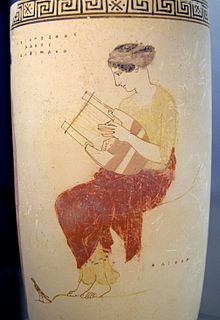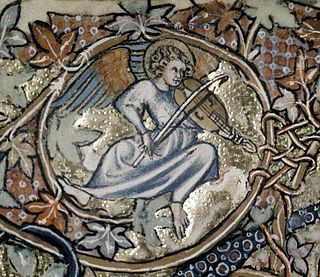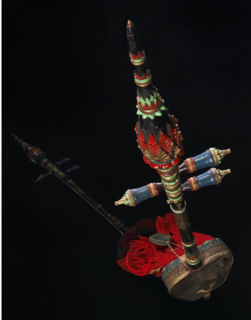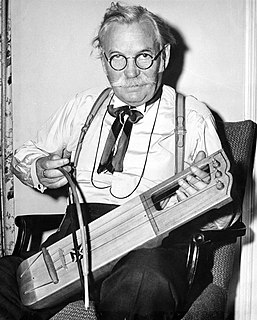
A fiddle is a bowed string musical instrument, most often a violin. It is a colloquial term for the violin, used by players in all genres, including classical music. Although in many cases violins and fiddles are essentially synonymous, the style of the music played may determine specific construction differences between fiddles and classical violins. For example, fiddles may optionally be set up with a bridge with a flatter arch to reduce the range of bow-arm motion needed for techniques such as the double shuffle, a form of bariolage involving rapid alternation between pairs of adjacent strings. To produce a "brighter" tone, compared to the deeper tones of gut or synthetic core strings, fiddlers often use steel strings. The fiddle is part of many traditional (folk) styles, which are typically aural traditions—taught "by ear" rather than via written music.

String instruments, stringed instruments, or chordophones are musical instruments that produce sound from vibrating strings when a performer plays or sounds the strings in some manner.

The lyre is a stringed musical instrument that dates back to 1400 BC in ancient Greece. It is known for its use in Greek classical antiquity and later periods. The instrument was created and used earlier, around 2600 BC, in the Middle East.

The crwth is a bowed lyre, a type of stringed instrument, associated particularly with Welsh music, now archaic but once widely played in Europe. Four historical examples have survived and are to be found in St Fagans National Museum of History (Cardiff); National Library of Wales (Aberystwyth); Warrington Museum & Art Gallery; and the Museum of Fine Arts, Boston (US).
In music, a bow is a tensioned stick which has hair coated in rosin affixed to it. It is moved across some part of a musical instrument to cause vibration, which the instrument emits as sound. The vast majority of bows are used with string instruments, such as the violin, viola, cello, and bass, although some bows are used with musical saws and other bowed idiophones.
Nordic folk music includes a number of traditions of Nordic countries, especially Scandinavian. The Nordic countries are Iceland, Norway, Sweden, Denmark and Finland.

The vielle is a European bowed stringed instrument used in the medieval period, similar to a modern violin but with a somewhat longer and deeper body, three to five gut strings, and a leaf-shaped pegbox with frontal tuning pegs, sometimes with a figure-8 shaped body. Whatever external form they had, the box-soundchest consisted of back and belly joined by ribs, which experience has shown to be the construction for bowed instruments. The most common shape given to the earliest vielles in France was an oval, which with its modifications remained in favour until the Italian lira da braccio asserted itself as the better type, leading to the violin.

Gusli is the oldest East Slavic multi-string plucked instrument, belonging to the zither family, due to its strings being parallel to its resonance board. Its roots lie in Veliky Novgorod in Novgorodian Rus'. It may have a connection to the Byzantine form of the Greek kythare, which in turn derived from the ancient lyre, or might have been imported from Western and Central Europe during the Middle Ages, when the zither had immense popularity. It has its relatives in Europe and throughout the world: kantele in Finland, kannel in Estonia, kanklės in Lithuania, kokles in Latvia, Zither in Germany, citera in the Czech Republic, psalterium in France and so on... Furthermore, the kanun has been found in Arabic countries, and the autoharp, in the United States. It is also related to such ancient instruments as Chinese gu zheng, which has a thousand-year history, and its Japanese relative koto. A stringed musical instrument called guslim is listed as one of the Me in ancient Sumer.
Traditional Inuit music, the music of the Inuit, Yupik, and Iñupiat, has been based on drums used in dance music as far back as can be known, and a vocal style called katajjaq has become of interest in Canada and abroad.
Bowed string instruments are a subcategory of string instruments that are played by a bow rubbing the strings. The bow rubbing the string causes vibration which the instrument emits as sound.

The rebab is the name of several related bowed string instruments that independently spread via Islamic trading routes over much of North Africa, Southeast Asia, the Middle East, and parts of Europe.

The jouhikko is a traditional, two- or three-stringed bowed lyre, from Finland and Karelia. Its strings are traditionally of horsehair. The playing of this instrument died out in the early 20th century but has been revived and there are now a number of musicians playing it.

The talharpa, also known as a tagelharpa or the stråkharpa, is a four-stringed bowed lyre from northern Europe. It was formerly widespread in Scandinavia, but is today played mainly in Estonia, particularly among that nation's Swedish community. It is similar to the Finnish jouhikko and the Welsh crwth. The instrument is still known in Finland.
The giga was a type of bowed lyre, it was very popular especially in Norway, but also common to find in England, Iceland and Denmark. It is considered to be extinct; however there are some interesting reconstruction projects. The name does not originate from Latin, but rather derives from an old Viking word that meaning for "to vibrate", "to move in a fast way": this term is also the origin for the name of the dance called Jig that is very common in Northern Europe, especially in the British isles.

The Icelandic fiddle is a traditional Icelandic instrument that can be described as a box with two brass strings which is played with a bow. The strings stretch across one end of the box to the other where they are tuned by two tuning pegs.

The tautirut is a bowed zither native to the Inuit culture of Canada.

A musical instrument is a device created or adapted to make musical sounds. In principle, any object that produces sound can be considered a musical instrument—it is through purpose that the object becomes a musical instrument. A person who plays a musical instrument is known as an instrumentalist. The history of musical instruments dates to the beginnings of human culture. Early musical instruments may have been used for rituals, such as a horn to signal success on the hunt, or a drum in a religious ceremony. Cultures eventually developed composition and performance of melodies for entertainment. Musical instruments evolved in step with changing applications and technologies.

Otto Emanuel Andersson was a Finnish musicologist.
The segankuru is a bowed trough zither, bar zither or musical bow, a string instrument found in Botswana and other areas of South Africa, and found under many names. It consists of a wooden body attached to a tin can resonator, with a single metal string played with a bow. The instruments main role is for self or group entertainment for young men, while herding cattle, etc.













